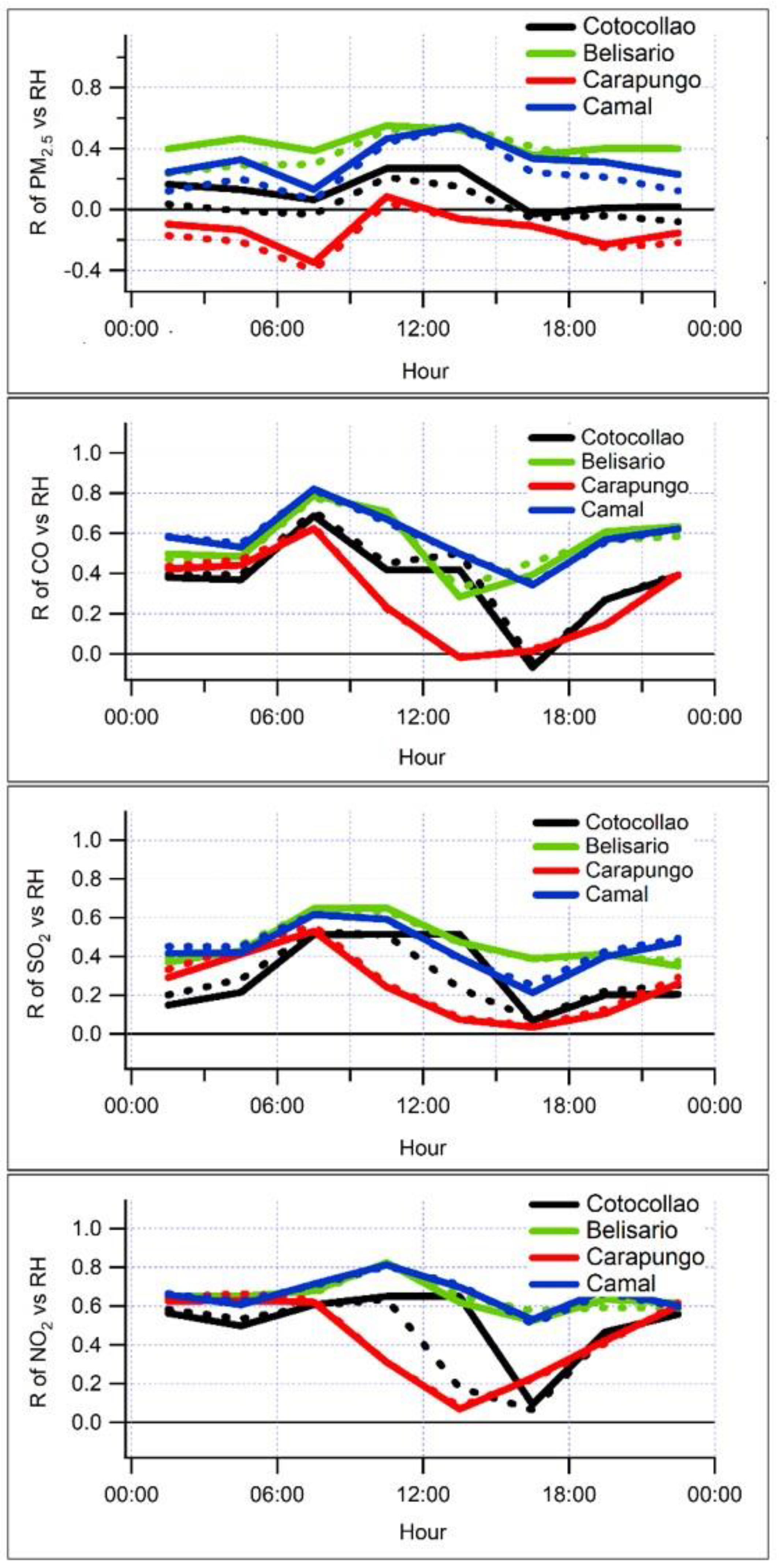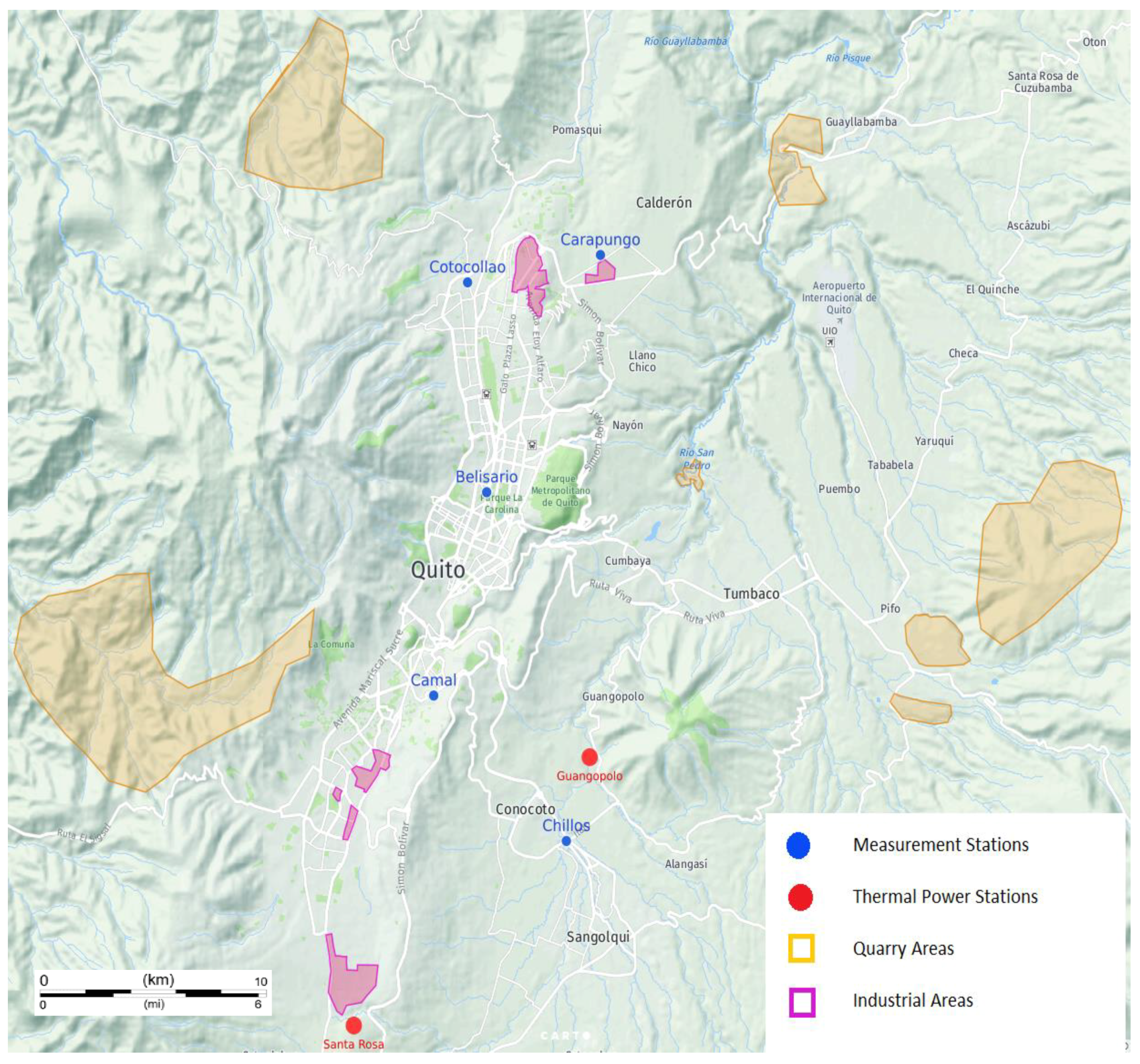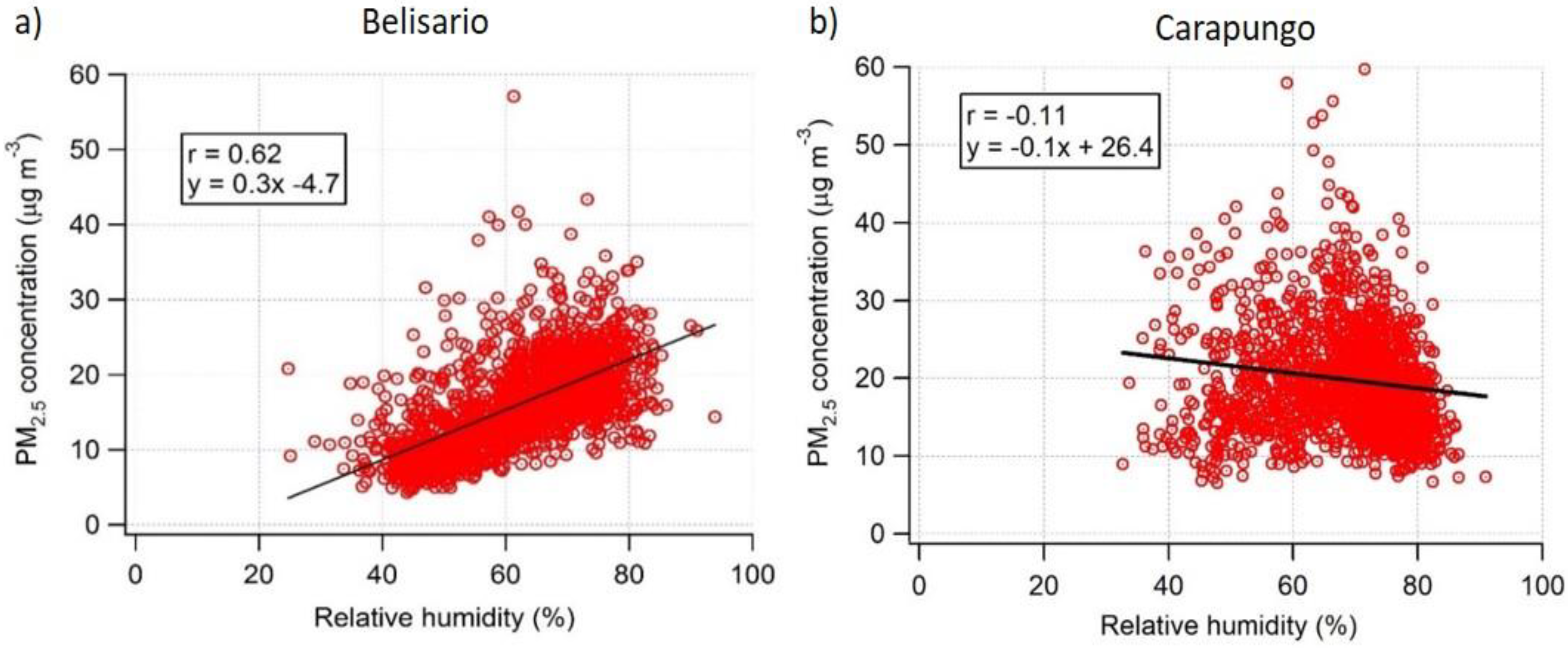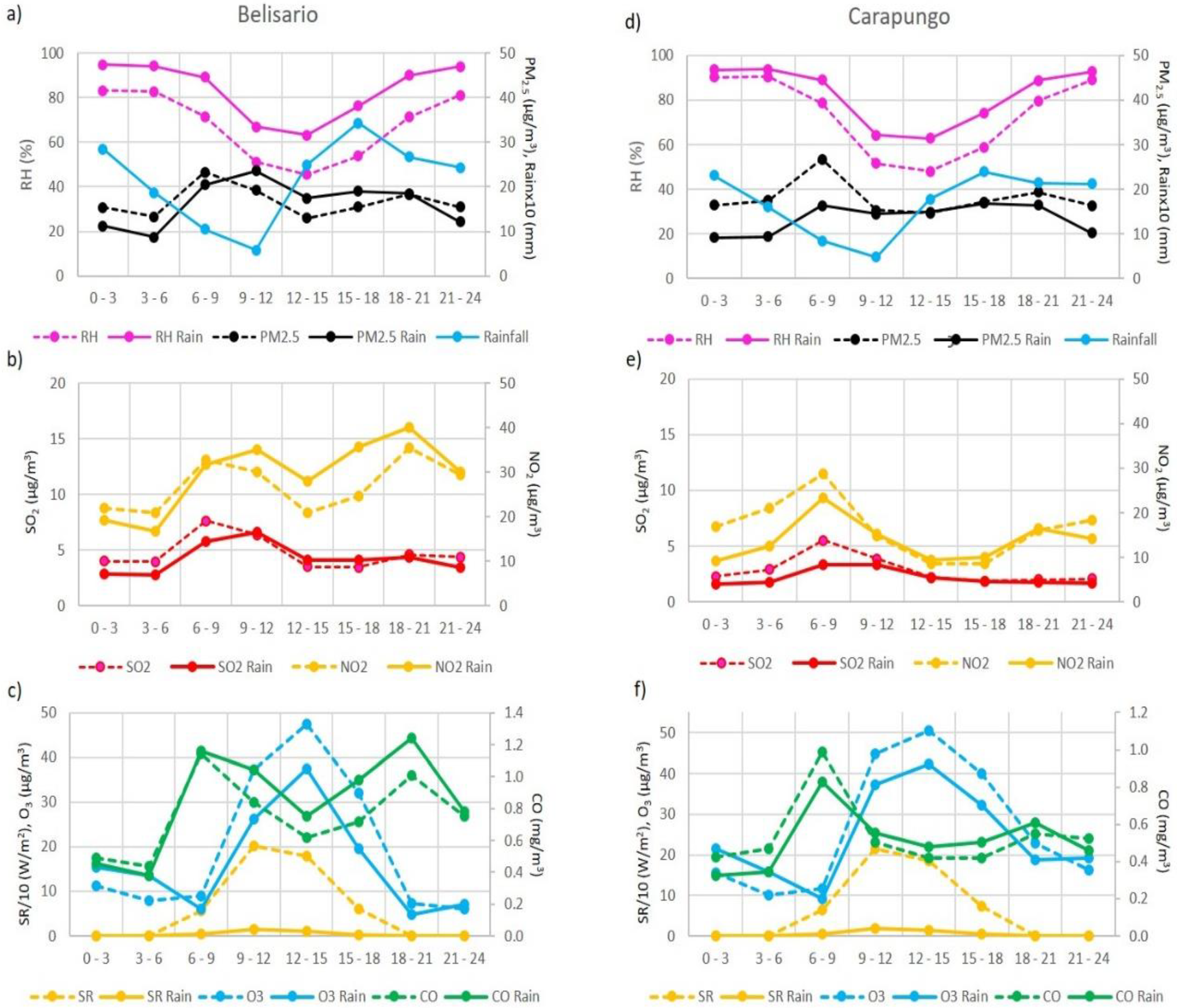3.1. Long Term Air Quality and Meteorological Data Analysis
The statistical analyses of daily data show that the 2007–2016 average RH for central Quito is relatively high at 69.9%, and that the annual average PM
2.5 concentration is elevated at 17.1 ± 6.05 µg/m
3 (median 17.0 µg/m
3). The area has been undergoing some changes in climate, with ambient temperature increase from 13.5 °C to 14.8 °C in the past decade. In the same period, the annual RH average steadily decreased from about 76% to 64% in all the monitored sites. The overall decreasing trend in PM
2.5 concentrations is registered in Belisario and Camal districts by 12.6% and 2.8%, respectively, while, in northern Cotocollao and Carapungo, we see a steady increase by 12.9% and 11.4%, respectively. As reported in an earlier study, these changes in annual concentrations are due to the implemented fuel and traffic regulations in the city of Quito and all of Ecuador, and a continued growth of the city at the outskirts [
4]. The gaseous criteria pollutants tend to be elevated depending on the location or season. For example, ozone tends to exceed WHO’s recommendations in September due to the high UV radiation (dry season, no cloud cover combined with direct sun angle), or SO
2 is elevated in the Chillos site located close to the thermoelectric power plant (see
Figure 1).
Although the city suffers from long-term elevated PM
2.5 pollution, mostly due to mobile sources coming from poor quality fuels and old technologies [
4,
36], it has limited resources to study chemical composition of particulate matter. To confirm the PM
2.5 correlation with other common mobile source emissions in an urban area, correlation analyses of PM
2.5 concentration data and CO, NO
2, SO
2, and O
3 concentrations was performed for all the sites (
Table A1,
Table A2,
Table A3,
Table A4,
Table A5,
Table A6,
Table A7,
Table A8,
Table A9 and
Table A10,
Appendix A). The results contrast for different sites. The best linear correlation was obtained at the Belisario site, where daily PM
2.5 concentrations were best correlated with NO
2 (
r = 0.67), CO (
r = 0.56) and SO
2 (
r = 0.52) (
Table A1 and
Table A2,
Appendix A). In addition, stronger ozone effect on weekends [
41] and increases in PM
2.5, SO
2, NO
2 and CO concentrations on weekdays were observed in Belisario, Cotocollao and Camal (
Table 1). These results support the fact that these contaminants originate highly from anthropogenic sources, with mobile sources being the main contributor. This analysis helped identify more traffic related areas in the city. The Chillos area contains a thermoelectric power plant, the alternators of which are driven by diesel-cycle internal combustion engines powered by diesel, fuel-oil, and reduced crude oil. This thermoelectric plant functions all week long and might not show a weekend drop in pollutant concentrations (
Table 1). In addition, this monitoring site has been functioning since 2014, thus providing fewer data, possibly influencing different trends. Our findings are consistent with the previous study resuming elemental composition of PM
2.5, where, depending on the zone, the contributing sources varied from natural, to traffic and industrial emissions [
36,
42]. Specifically, high enrichment factors for Zn, V, Ni, As, and Pb implied that the industrial and vehicular emissions are a major source in the Quito urban air shed.
Correlations of criteria pollutants (PM
2.5, O
3, SO
2, NO
2 and CO) with all the meteorological parameters were also studied (
Table A1,
Table A2,
Table A3,
Table A4,
Table A5,
Table A6,
Table A7,
Table A8,
Table A9 and
Table A10,
Appendix A). The best correlation with meteorological parameters was obtained for the central Belisario site, with an exception for insignificant impact of atmospheric pressure and precipitation on PM
2.5 and SO
2. At this site, once RH increases, all criteria pollutants increase with the exception of ozone (
Table A1 and
Table A2,
Appendix A). At all sites except Carapungo, while temperature, wind speed and solar radiation have negative correlation with air pollution, the precipitation positively correlates with NO
2, SO
2 and CO, and negatively with O
3. The region experiences windy conditions during the sunny days, confirmed by the pollution negative correlation with wind speed and solar radiation.
3.2. RH Impact on Urban Pollution
Significant positive RH vs. PM
2.5, CO, SO
2 and NO
2 correlations were found in the central Belisario area (
Table A1 and
Table A2,
Appendix A). An additional 3-h average analysis also showed a stronger positive correlation during the rush hours for all the sites (except PM
2.5 in Carapungo) (
Figure A1,
Appendix B). The two sites showing the most different correlations between RH and pollution are Belisario, a lightly residential area surrounded by a dense urban street network, and Carapungo, a highly industrial area (
Figure 1). A
t-test shows a strong significant interaction effect between these two sites (Belisario vs. Carapungo) for relative humidity and PM
2.5 (
p = 0.000) and CO (
p = 0.000) concentrations. This outcome is a statistical confirmation that, the more the RH increases, the more the PM
2.5 and CO concentrations increase in the traffic-busy Belisario site, while it is opposite in the industrial Carapungo site (
Figure 2).
To further study the RH effect on fine particulate pollution, the average daily PM
2.5 concentrations and the daily RH data correlation analysis for the period 2007–2016 were performed (
Figure 3). For the traffic-busy Belisario site, data show that, the higher the daily average RH, the higher is the PM
2.5 concentration (
r = 0.46) (see
Figure 3a). In addition, the same positive dependence trend was identified for the effect of absolute humidity on the PM
2.5 pollution (
r = 0.46). However, the daily PM
2.5 average concentrations begin to decrease when RH reaches a certain high threshold level around 70%. Although the average daily RH varies from 40% to 95%, at high RH, it is difficult to identify a trend in the PM
2.5 concentrations. While the highly residential Cotocollao and Chillos sites had a similar positive correlation trend to the traffic-busy Belisario site, the industrial Carapungo and Camal sites had a negative correlation between RH and PM
2.5 concentrations (
Figure 3b and
Appendix A). This suggests that the RH effect on PM
2.5 concentrations depends on the type of the aerosol source, which is coherent with the nature of the urban areas depicted in
Figure 1.
As high RH and elevation both reduce the oxygen in the intake air of internal combustion engines, this results in incomplete combustion, producing greater PM
2.5 emissions at the level of each individual vehicle. Any increase in the RH also favors nucleation of sulfuric acid during the exhaust dilution, thereby increasing the formation of PM [
10,
30]. This effect is of greater relevance in cities with motorized fleets that consume fuels with a high sulfur content, common in developing countries. Since the RH reduces the motor performance, it suggests that the source of pollution is (mostly) traffic based in Belisario (and Cotocollao and Chillos) and more industry based in Carapungo (and Camal). In addition, previous study has suggested that the principal source of air pollution in Carapungo seems different from the central Quito site, since it is minimally brought by the main traffic highway [
12]. These differences over quite a small area are caused by the fact that the city is positioned in very complex terrain, forming microclimates with different weather conditions. Moreover, in most Latin American urban areas, there is a strong social segregation. Therefore, a different pollution correlation was found in the two poorer areas of Quito, the outskirts in the south and north, where, in addition to industrial activities, the other pollution sources might be more difficult to identify, for example charcoal cooking (in the streets), worse roads, older vehicles, poorer maintenance, etc.
3.3. Contrasted Precipitation Effect on RH Impact on PM2.5 Concentrations
Since high RH is often a predictor of precipitation events, precipitation accumulation was added as a third component (color scale) in
Figure 3. In the case of the traffic-busy Belisario site (
Figure 3a), high RH with precipitation decreases PM
2.5 concentrations due to wet deposition processes such as precipitation scavenging of particles and below-cloud scavenging of gases [
43]. In the case of the industrial Carapungo site, the overall influence of the rainfall on the RH and PM
2.5 correlation is negative (see
Figure 3b).
We argue that the effect of the RH on PM
2.5 concentrations may be masked in data interpretation by the cleaning effect of rain events, thus making it necessary to differentiate the rainfall. Therefore, to further study the precipitation effect on RH impact on PM
2.5 pollution, we split the daily data into two separate analyses: (i) the RH and PM
2.5 correlation with daily rain accumulation; and (ii) the RH and PM
2.5 correlation without daily rain accumulation. In the traffic-busy areas of central Quito, the level of rain accumulation affects the PM
2.5 pollution (see
Figure 4 for Belisario). We estimated that PM
2.5 and RH correlation coefficient changes from positive values to negative when daily precipitation accumulation is over 1 mm, confirming the findings in Zanzhou, China (elevation 1520 m.a.s.l.) [
14]. The latter study indicates that, while the coarse particles (>2.5 μm) are scavenged by almost any amount of precipitation, to remove the fine and submicron aerosols they have to be exposed to a much stronger rain event. Thus, with daily rain accumulation of up to 1 mm (red markers,
Figure 4a) and low RH, the daily average PM
2.5 concentrations increase with increasing RH. The correlation coefficient stabilizes from 1 mm to 8 mm of daily precipitation accumulation (at
r = −0.26), and becomes more significantly negative after 9 mm, which was identified in this study as a threshold for a strong rain event. As an example, during days of light to moderate rainfall (1–8 mm), the average RH is 76% and the PM
2.5 concentrations are 18.9 µg/m
3 whereas during days of stronger rain events (>9 mm), the average RH is 83% and the PM
2.5 concentrations are 17.7 µg/m
3. In the case of more substantial rain accumulation, the average daily PM
2.5 concentrations decrease notably (
r > −0.29) with higher RH (rainbow markers,
Figure 4b), indicating a cleaning effect of precipitation. This type of analysis was not necessary for the industrial Carapungo site, as the correlation is always negative and increasing RH independently of precipitation always helps reduce the concentrations of all atmospheric criteria pollutants (
Figure 3b).
In the case of rain-free days in Belisario, the daily average RH varies from about 40% to 85% (averaging 62%) with daily average PM
2.5 concentrations varying from 8 to 22 µg/m
3 (averaging 15.9 µg/m
3) (
Figure 5a). This analysis confirms that daily average concentrations of PM
2.5 increase (
r = 0.62) with increasing average RH. The better correlation coefficient of PM
2.5 concentrations to RH on days with no rain events confirms the scavenging effect of precipitation. We can also conclude that daily average PM
2.5 concentrations above healthy limits (>25 µg/m
3) are commonplace in the presence of high RH. We also highlight that the average daily PM
2.5 concentration is higher during the days with rain events, independently of the rain accumulation, if compared to the days without precipitation. This could be explained by higher relative humidity during those days, causing reduced combustion efficiency. For the industrial Carapungo site,
Figure 5b shows that the increasing relative humidity even during the days of no rain events results in a negative correlation, suggesting other removal processes in the area. Carapungo is prone to night fog episodes, which might explain the PM
2.5 removal effect of high relative humidity in the absence of rain events.
A 3-h average data analysis was performed separately for the days with rain events and no rain events. First, the data show that RH is higher during the days with rain events, and more so for the central traffic-busy Belisario site (10–20% higher) (
Figure 6a). In addition, the precipitation events are common in the afternoon, and are stronger (more accumulation) at this site. The only similarity between the two contrasting sites is ozone that is present in significantly lower concentrations during the rainy days, due to the reduced photochemistry, caused by the drop in solar radiation (
Figure 6c,d). The data show that, at night and early morning the PM
2.5 (
Figure 6a,d), CO (
Figure 6c,d), NO
2 and SO
2 (
Figure 6b,e) concentrations are higher during the days with no rain if compared to the days with rain. Meanwhile, during the daytime, the fine particle and gas pollution is relatively higher if it rains that day in the traffic-busy Belisario site. In the industrial Carapungo site, the NO
2 and CO increases during the rush hours, suggesting the effect of reduced combustion efficiency. This confirms our previous findings of categorization of rain event strength, showing an increase in PM
2.5 concentrations during the minimum rain accumulation at 9:00-12:00. The latter depends on solar radiation, which is reduced during the rainy days, due to an increased cloud cover, and due to NO
2-containing products transferring to particle phase during the high RH events [
44]. It can be noted that the RH variation is lower, and overall values are higher in industrial Carapungo without rain events, if compared to the traffic-busy Belisario site. The precipitation accumulation is lower in this area, suggesting other type of particle removal mechanisms, such as fog and low clouds. This high altitude region is often covered by clouds during the dark hours of the day. Finally, in both contrasting sites (and the rest of Quito), there is less diurnal variation in PM
2.5 concentrations during the days with precipitation events, or lack of rush hour traffic peak. The PM
2.5 concentrations decrease during the days with rain events, indicating the clearing effect of precipitation. In the central traffic-busy Belisario site, in addition, the morning rush hour peak shifts one hour later, which can be explained by an increase in traffic in general, traffic collapse, people being late, and increased taxi use (longer rush hour).
According to the IMPROVE formula [
45,
46,
47,
48,
49,
50,
51,
52,
53], the light extinction factor of the atmosphere depends on the chemical composition of the particles, and its hygroscopic growth ability as a function of relative humidity. Thus, depending on the chemistry of the particle, it might contain more water in the events of increasing relative humidity. This would result in an increase in concentrations with increasing RH. In our study, we registered a clear increase in the particle concentrations with an increasing RH in the traffic-busy residential areas, while, in the industrial areas, we see a decreasing effect. This suggests a contrasting effect of PM and RH due to different particle chemistry. This confirms the findings of other studies in industrial and rural [
11,
20], and urban [
15,
16,
17,
18,
19,
20,
24,
54] areas. While we are not able to provide a chemical composition analysis of PM
2.5 due to limited resources, we see that in traffic-busy areas concentrations of PM
2.5 and combustion gases increase with increasing RH. This suggests that both come from primary motorized traffic emission. In addition, several studies state that most urban particulate pollution is generated by the motorized fleet, the emissions of which increase with the increasing RH and elevation [
26,
27,
28,
29,
30,
31,
32,
33,
34,
35]. In addition, the diurnal trends of PM
2.5 display a clear morning rush hour peak, which might confirm that a significant fraction of PM
2.5 is of primary origin [
55,
56]. The IMPROVE formula is strongly based on the secondary aerosol (ammonia and nitrate) fraction, which might suggest that it would not greatly change the variation in PM
2.5 concentrations due to water content [
24,
54,
57]. Finally, our instruments are equipped with the heated sampling tube that removes water in the events of RH above 35%.
In addition to the effect of RH on aerosol pollution in cities at high elevations, there are several other transport-related factors that trigger higher emissions, such as road surface quality, brakes and tire wear due to more speeding and braking required where the roads are on slopes. In the case of Quito, the driving style and the conditions result in more braking and accelerating and, thus, more PM
2.5 emissions, all of which are amplified by elevation [
30]. Furthermore, vehicle exhaust emissions may impact the surrounding engines’ combustion efficiency in conditions combining high elevation and RH, a fact of even greater significance in cities with multiple traffic jams.
3.5. Models
The long-term median PM
2.5 concentration of 17.0 µg/m
3 for Quito was used to study the dependence of PM
2.5 concentrations on daily precipitation and the RH (
Figure 8). This classification boundary indicates whether the PM
2.5 concentrations are above or below the median value, which is preferred to the average, because it allows us to get fully balanced classes (same number of instances or observations in each class). In machine learning, if the classes are not balanced, there is a risk that the algorithm classifies on the majority class. In other words, by using the median, we assure that the classification baseline is 50% (random choice between the two possible classes). Thus, the objective is to produce a model that provides an accurate classification significantly better than 50%. Moreover, the long-term median (17.0 µg/m
3) and the average (17.1 µg/m
3) values are very close to each other, therefore the classification boundary in this case will result in similar boundary even if the average value was used. A logistic regression was used to minimize a cost function
J(
θ) such as:
where
m is the number of observations,
y is the actual value and the hypothesis (or prediction)
hθ(
x) is given by the sigmoid model as follows:
where the sigmoid function
g is defined as:
A batch gradient descent algorithm was used to perform this minimization, in which each iteration executes the following update:
With each step of gradient descent, the parameter
θj comes closer to the optimal values that achieve the lowest cost
J(
θ). The
θj that provides the lowest
J(
θ) represents the slope of the logistic regression, which best separates the two classes of PM
2.5 concentrations. Equations (5) and (6) represent the boundary, obtained using the logistic regression method, for Belisario and Carapungo, respectively. The positive value of the slope for Belisario (slope = 1.132) and the negative value of the slope for Carapungo (slope = −0.572) were calculated:
The accuracy of this classification is 69% for Belisario and 65% for Carapungo. These values are calculated through the equation as follows:
where
TP are the true positives (>17.0 µg/m
3) and
TN are the true negatives (≤17.0 µg/m
3). These variables are the correctly classified instances. The wrongly classified instances
FP and
FN are false positives and false negatives, respectively. The confusion matrix in
Table 2 and
Table 3 represent the way the logistic regression model classifies the data for Belisario and Carapungo, respectively. A
t-test showed that the classification accuracy for both models is significantly different from the baseline (
p < 0.05).
These models showed that, while, in the traffic-busy Belisario region, stronger precipitation events are necessary to reduce the PM2.5 pollution when the RH increases, in the industrial Carapungo site, the higher the RH the lower is the pollution independently of the presence of rain. In addition, in all sites of Quito, except Carapungo, rain has an overall positive effect on the gaseous pollution, while, in most of the sites (Belisario and Chillos insignificant effect), it reduces the PM2.5 concentrations.
In the traffic-busy Belisario, the daily average PM
2.5 concentrations were usually below 17.0 µg/m
3 with RH under 67% (the blue area,
Figure 8a), as can also be confirmed in
Figure 3a. If the RH is over this threshold (the brown area), there must be rain to reduce the PM
2.5 concentrations to less than the median. Equation (5) identifies precisely the minimum daily precipitation accumulation required to keep PM
2.5 under 17.0 µg/m
3 in relation to the RH. In the industrial Carapungo site, the effect was the opposite (
Figure 3b and
Figure 8b). In this industrial zone the level of rain accumulation had little effect and pollution got smaller with an increasing RH (see Equation (6) for the mathematical boundary between PM
2.5 > 17.0 µg/m
3 vs. <17.0 µg/m
3). Interestingly, similar results were achieved for the analysis of other chemical pollutants such as CO. This difference in the process of pollution removal between the traffic-busy Belisario and the industrial Carapungo sites suggests a distinct nature of pollution source in each site.
















